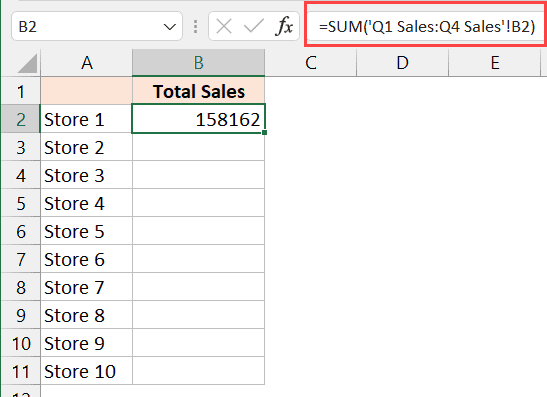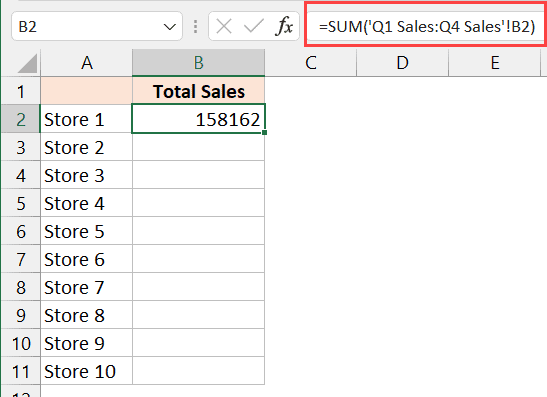Excel Sheets: How to Add Cells Across Different Sheets

Many of us are familiar with the power of Microsoft Excel, whether for managing personal finances, tracking sales in business, or organizing data for academic research. One of Excel's most useful features is its ability to perform calculations across multiple sheets. Imagine having the data for monthly expenses, project costs, or sales figures spread out over several sheets and needing to calculate the total. This might seem daunting at first, but Excel has provided several ways to simplify this task. In this comprehensive guide, we'll delve into how you can add cells across different sheets, optimizing your workflow with Excel.
Why Add Cells Across Different Sheets?

Before diving into the methods, let's consider why this functionality is essential:
- Consolidation: Pulling data from various sheets to create summaries or reports.
- Comparison: Easily compare data from different periods or departments.
- Automation: Automate calculations that would otherwise require manual intervention, reducing human error.
Methods for Adding Cells Across Sheets

Using the SUM Function

Excel’s =SUM() function is versatile and can be used to add numbers across sheets. Here’s how:
- Identify the cells: You'll need to know the cell references for the data you want to sum.
- Open a cell: Click on the cell where you want the sum to appear.
- Enter the formula: Type
=SUM(Sheet1!A1, Sheet2!A1, Sheet3!A1). This formula sums the values in cell A1 from sheets named Sheet1, Sheet2, and Sheet3. - Hit Enter: Excel will calculate and display the total.
🗒️ Note: If the sheets are numerous, manually entering each reference can be tedious. Consider the next method for bulk operations.
Using 3D References

If your sheets follow a sequence and you want to sum the same cell across all of them, 3D references make this process seamless:
- Navigate to the destination sheet: Go to the sheet where you want the sum to appear.
- Select the cell: Click on the cell for the total.
- Enter the formula: Type
=SUM(Sheet1:Sheet3!A1). This command will sum cell A1 from all sheets named Sheet1 through Sheet3. - Enter: The sum of A1 from all those sheets will appear.
Leveraging Named Ranges

Named ranges can significantly simplify your work:
- Define a named range: For instance, name cell A1 on Sheet1, Sheet2, and Sheet3 as "MonthlySales."
- Use in formula: In any sheet, you can now use
=SUM(MonthlySales)to sum all cells named "MonthlySales."
Using a Consolidate Feature

If you’re dealing with multiple ranges or complex data sets:
- Go to the Data tab: Click on the "Data" menu.
- Select Consolidate: Choose "Consolidate."
- Choose your function: Select "Sum" from the drop-down list.
- Add references: Add references from different sheets, ensuring the cell references are consistent.
- Click OK: Excel will consolidate the data into the specified destination range.
💡 Note: Consolidation can also link data, so updating one sheet will automatically update your consolidated view.
Using External References

For situations where you need to reference data in another workbook:
- Open the source workbook: Make sure the workbook with the data is open.
- Enter the formula: Type
=[SourceWorkbook.xlsx]Sheet1!A1+..., where "SourceWorkbook.xlsx" is the name of the workbook, and "Sheet1!A1" is the cell you're referencing. - Press Enter: The value from the external reference will be included in your calculation.
Excel's ability to link and reference data across sheets offers a versatile approach to managing, analyzing, and reporting data. Whether you're summarizing monthly expenses, tracking project milestones, or aggregating sales data, these methods can streamline your tasks and reduce errors. Here are some final thoughts:
- When working with large datasets, use named ranges for ease of reference.
- 3D references can significantly reduce the complexity of your formulas when dealing with sequential sheets.
- Consolidate and link options offer dynamic ways to keep your data synchronized across sheets.
- Always consider the scalability of your solutions. As your data grows, will your current method still be efficient?
- Regularly saving and organizing your workbooks will make cross-sheet calculations smoother and more accurate.
By mastering these techniques, you'll unlock the full potential of Excel for complex data analysis, ensuring that your spreadsheets are not just containers of data but powerful tools for decision-making and reporting.
Can I use functions other than SUM for cross-sheet calculations?

+
Yes, you can use a variety of functions for cross-sheet operations, like AVERAGE, MAX, MIN, COUNT, etc. The process remains similar; you just substitute SUM with the function of your choice.
What happens if I change the order or names of the sheets?

+
If you rename or reorder sheets, Excel’s references will break. However, if you use named ranges or external references, they can adjust automatically if the cells themselves are moved. Use relative references when you anticipate changes to ensure your formulas remain intact.
Is there a performance impact when using multiple sheets?

+
Yes, large calculations across many sheets can slow down Excel. Use efficient formulas, close unnecessary workbooks, and leverage named ranges to minimize overhead when possible.
How can I make sure my formulas always reference the correct sheets?

+
Named ranges and external references provide more stable references. If sheets might be renamed or moved, it’s also beneficial to use Excel’s features like organizing sheets into folders or using sheet protections.
What are some common errors when summing across sheets?

+
Common errors include: Incorrect sheet name or reference, circular references, incorrect cell ranges, and mismatching data types. Always double-check your references and ensure the data you’re summing is consistent in format.



